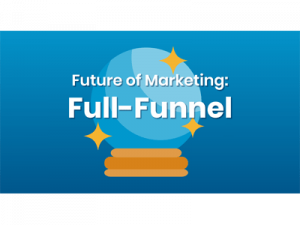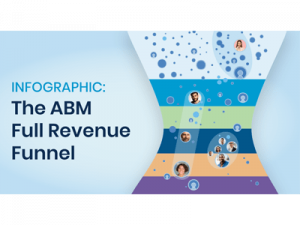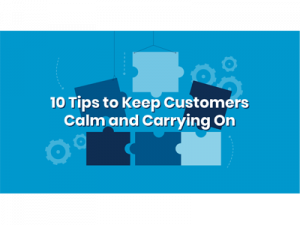Account Penetration Strategies with Account Based Marketing
Keep your brand in front of your most important customers with Terminus ABM. See how you can retain and expand key customer accounts in this new Terminus ebook.


The #1 ABM Platform for Your Account Penetration Strategy
Learn more about the Terminus platform and how it gives account managers endless ways to stay in front of their most important customers. Increase adoption, reduce churn, and promote cross-sell opportunities.

The Future of Marketing is Full-Funnel: Perspective from Terminus CEO, Tim Kopp
READ THE BLOG
The Account Based Marketing Full Revenue Funnel
READ MORE
10 Tips to Keep Customers Calm and Carrying On
read tips nowAccount Penetration Strategies
Account relationships are often measured via an important metric called “account penetration.” Account penetration compares the amount of spend that a customer has with your company versus other companies. In other words, how committed is the company to maintaining its relationship with you?
Numerous account penetration strategies formulate the basis of how to increase revenue and how to sell SaaS B2B. In the eCommerce and SaaS markets, account penetration becomes critical. The less account penetration a company has, the more likely it is that the customer might leave. By measuring penetration as part of overall strategic account manager performance goals, companies can see whether they are actually becoming essential to their clients’ infrastructure.
Much of this has to do with selling to existing customers vs new customers and how to target existing customers. Sales professionals need to look into their account review presentation and how to penetrate enterprise accounts if they want to increase lifetime value.
Consider a customer with an enterprise infrastructure that is 20% Microsoft and 80% Apple. Though they may have maintained a relationship with Microsoft for many years, it’s patently obvious that it is easier for them to switch to a 100% Apple ecosystem rather than a 100% Microsoft ecosystem — the account, regardless of its age, is at jeopardy.
Furthermore, a Microsoft sales professional would be leaving 80% of their potential revenue on the table, because these are services that Microsoft could provide, and because they are customers they already work with. Likewise, the Apple professional is doing the same: They could likely secure that additional 20% through customer loyalty, and it would likely be easier than trying to sell the same products to a brand new customer.
Cross Selling
When companies introduce new products and services, cross selling becomes only natural — the act of encouraging existing customers to make a purchase. Foremost, sales professionals understand their customers’ needs, and they will know whether a product or service is going to be useful to them. Letting them know about these products and services is a way to build relationships, and to add value to the services that are already provided.
Cross selling and upselling strategies need to be adjusted to a new market and new temperaments. Modern cross selling best practices really need to present value to the customer. Customers today don’t work well with hard sell tactics; they are more likely to simply ghost a business or service than to try to commit. And while it’s easy to find the classic “it’s easier to sell to existing customers” quote and paraphrases, it’s seldom discussed how to sell without alienating them.
Sales professionals need to know how to sell new products while presenting it as though it is an opportunity. Ideally, the product and services professionals at a business are working hard to make sure that the things they provide are interesting to the clients that you have. Cross selling statistics also show that customers are more likely to make purchases if they trust you and have a good relationship with you. So the core of how to get more business from existing clients is really to foster relationships and understand their needs.
Consider this sales pitch to existing customers. A food supplier has a new brand of inventory in. Obviously, they should be selling new products to existing customers: Those customers are looking for a variety of foods, and now there is another opportunity to purchase. But on the other end of the spectrum, consider a SaaS company that now has a new machine learning inventory application. They shouldn’t try to sell this to companies that don’t maintain significant inventory: It will only spoil the relationship.
Customer Retention
With all this talk of account penetration and cross selling, customer retention shouldn’t get lost. Customer retention, the act of maintaining customer continuity and keeping customers buying, is far more important. After all, you can’t resell to customers that have already left.
In many ways, the two strategies have overlap. A customer is retained by maintaining relationships. Customers buy when those relationships are maintained. And if you aren’t continually selling to your customers, you can’t consider them retained; they’re former customers, not current customers.
All this highlights an important need for customer retention strategies and a customer retention model. There are customer retention strategies in CRM solutions, such as analysis given about customers likely to leave. There are also white papers and customer retention strategies PPT slides that can give you more insights into what really “retains” a customer. If you want to know how to increase customer retention rate as a whole, you need to look at your industry first; SaaS companies will have far different retention rates compared to brick-and-mortar retail stores.
If you want to know how to retain customers in retail, you need to look towards your local competition. If you want to retain customers in SaaS, you may need to look the world over.
While products and services matter, customers are actually more likely to leave companies over customer service. Why should a salesperson handle customer complaints promptly? Because a customer who complains is a customer that is likely to leave. Customers want to feel valued and they want to have positive interactions with a company or a brand. Sales professionals are the first line of contact for most businesses, and thus need to do the most work to make sure that the customers feel that they are giving their business to the right place.
Terminus is a software platform that can help with customer marketing and retention, by bringing together the information that account managers need to make educated decisions about the relationships with stakeholders they secure, maintain, and follow.
Customer Marketing
Customer marketing is simply the act of marketing to existing customers. If you’ve ever wondered how to increase sales with existing customers, you have considered customer marketing. B2B customer marketing is very connected to a general customer service marketing strategy: It’s about making sure that you’re fulfilling whatever needs your customers have.
To understand this in full, consider a few customer marketing examples:
- A wine shop might give customers gift cards to give to their friends. They’re marketing to customers, but also promoting customer to customer marketing. The customers feel as though they are getting a “deal” to give to their friends, and their friends will trust the customer’s review of your business.
- A retail company may send out discounts to its most loyal customers. The customers feel valued and rewarded, while the company may be able to convince the customers to come in and find things that they want to purchase.
- A SaaS business can send out mailers to existing clients regarding new plug-ins, add-ons, and services they’re providing. The customers will feel as though the business is delivering more value to them now, and the relationship will be strengthened.
It can be difficult to know how to keep in touch with existing customers without seeming overly pushy. Marketing campaigns for existing customers have to strike a balance: They need to push the customer to purchase without being too sales-oriented. But once an organization knows how to leverage existing customers, they can greatly improve their customer lifetime value, and lower the costs of acquisition and retention.
Enterprise Software Sales
Enterprise software sales is a type of B2B selling that requires its own sales strategy. An enterprise sales strategy requires that a sales professional understand the relationships that companies have with their B2B enterprise software. Some companies are looking to upgrade and change, and some companies need to be approached. But either way, companies seldom make decisions about their sales software on a whim.
When prospecting enterprise accounts, sales professionals need to understand that for a company, their infrastructure is incredibly important. When their infrastructure is disrupted, their ROI goes down. Transitioning from a small business to enterprise, on the other hand, is often a transitional time in which companies need change management. This highlights an important aspect of selling to enterprise: being able to identify opportunities.
Enterprise sales are more difficult than selling to small or mid-sized companies. They tend to look at the history of a brand; a startup selling to enterprise clients is especially challenging. There are more stakeholders involved, a generally slower sales cycle, and trick processes. They may have additional regulations they need to follow, and their pain points may not be urgent enough to give them the momentum they need to seek to adopt new infrastructure.
That being said, though it is harder to hook an enterprise client, it’s often far more rewarding. Enterprise clients have higher lifetime values. They are less likely to leave a company once they have found a company that they want to work with, and they are far more willing to make big ticket purchases throughout the relationship.
Account Management Framework
An account manager and a sales representative are not the same thing, though there is some overlap. A sales representative is someone who is focused on securing sales, whether it be with existing customers or new customers. But an account manager is someone charged with taking personal care of the accounts of the business: It’s a more intimate relationship. Most companies need account managers; they need someone taking care of their customers and making sure that all sales are being captured. But that also requires an account management framework, or it can become tedious at best, overwhelming at worst.
The account management process begins when accounts are on-boarded, and it doesn’t end once they leave. Any account management strategy presentation will also include being able to recapture lost clients, or marketing towards clients that have already left.
An account management solution can provide key account management tools, such as easy page navigation, and the ability to quickly search through and analyze accounts. The right software suites can identify which products a customer is most likely to purchase, as well as whether a customer might be likely to leave.
Account managers need to leverage technology or they are limited in terms of scale regarding the number of accounts they can manage at once. One of the most important account manager tips is simply to be organized. Account management for dummies can go over many processes and techniques, but at the end of the day, it’s the technology that’s going to matter the most. For existing customer management, there are platforms such as HubSpot account management.
Account managers may wonder how to get customers to update their information, how to track customers, and how to integrate information that they find from sources such as LinkedIn. All this is generally included within an account management solution.